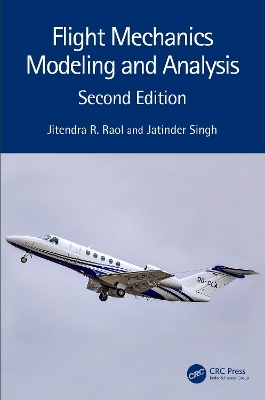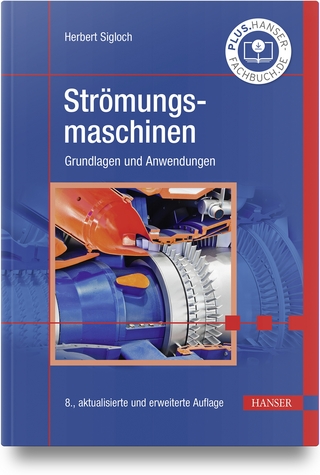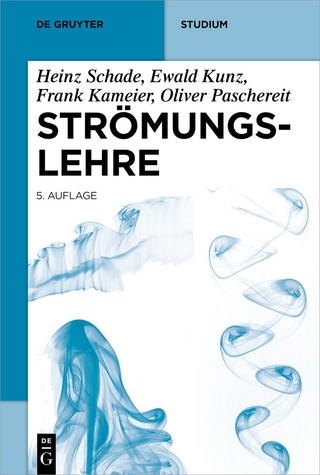
Flight Mechanics Modeling and Analysis
CRC Press (Verlag)
978-1-032-27609-0 (ISBN)
Flight Mechanics Modeling and Analysis comprehensively covers flight mechanics and flight dynamics using a systems approach.
This book focuses on applied mathematics and control theory in its discussion of flight mechanics to build a strong foundation for solving design and control problems in the areas of flight simulation and flight data analysis. The second edition has been expanded to include two new chapters and coverage of aeroservoelastic topics and engineering mechanics, presenting more concepts of flight control and aircraft parameter estimation.
This book is intended for senior undergraduate aerospace students taking Aircraft Mechanics, Flight Dynamics & Controls, and Flight Mechanics courses. It will also be of interest to research students and R&D project-scientists of the same disciplines.
Including end-of-chapter exercises and illustrative examples with a MATLAB®-based approach, this book also includes a Solutions Manual and Figure Slides for adopting instructors.
Features:
Covers flight mechanics, flight simulation, flight testing, flight control, and aeroservoelasticity
Features artificial neural network- and fuzzy logic-based aspects in modeling and analysis of flight mechanics systems: aircraft parameter estimation and reconfiguration of control
Focuses on a systems-based approach
Includes two new chapters, numerical simulation examples with MATLAB®-based implementations, and end-of-chapter exercises
Includes a Solutions Manual and Figure Slides for adopting instructors
Jitendra R. Raol received his B.E. and M.E. degrees in electrical engineering from M.S. University (MSU) of Baroda, Vadodara, in 1971 and 1973, respectively, and a Ph.D. (in electrical & computer engineering) from McMaster University, Hamilton, Canada, in 1986. He joined the National Aeronautical Laboratory (NAL) in 1975. At CSIR-NAL, he was involved in the activities on human pilot modeling in fix- and motion-based research flight simulators. He re-joined NAL in 1986 and retired in July 2007 as Scientist-G (and Head, flight mechanics and control division at CSIR-NAL). He was a Fellow of the IEE/IET (United Kingdom) and a senior member of the IEEE (United States). He is a life-fellow of the Aeronautical Society of India and a life member of the Systems Society of India. He has published nearly 150 research papers and numerous technical reports. He had guest-edited two special issues of Sadhana and two special issues of the Defense Science Journal (New Delhi, India). He co-authored an IEE/IET Control Series book, Modeling and Parameter Estimation of Dynamic Systems (2004), a CRC Press book, Flight Mechanics Modeling and Analysis (2009), a CRC Press book, Nonlinear Filtering: Concepts and Engineering Applications (2017), and a CRC Press book, Control Systems: Classical, Modern, and AI based Approaches (2019). He has also authored CRC Press books: Multi-Sensor Data Fusion with MATLAB (2010), and Data Fusion Mathematics: Theory and Practice (2015). He also edited a CRC Press book, Mobile Intelligent Autonomous Systems (2012). Jatinder Singh is a chief scientist and heads the division of flight mechanics and control at the CSIR-NAL, Bangalore. In 1998, he joined as a senior scientist in the flight mechanics and control division of the National Aeronautical Laboratory (NAL). He has a PhD from IIT, Kanpur. He was a recipient of the Alexander von Humboldt fellowship and has worked as a guest scientist at the DLR Institute for Flight Systems, Braunschweig, Germany before joining NAL. He is a senior member of the AIAA, and a life member of Aeronautical Society of India and the Systems Society of India. He is recipient of the NAL foundation day award and was also a member of the team, under the leadership of Dr. J. R. Raol, that won the CSIR technology shield for the year 2003 that was awarded to the flight mechanics and control division of NAL for their contribution to the integrated flight mechanics and control technology for aerospace vehicles. He has several conference and journal papers to his credit. He has also co-authored the book, Modelling and Parameter Estimation for Dynamic Systems, published by the IEE/IET, London, UK in 2004. He has been extensively involved in aircraft modelling and parameter estimation work and has made significant contribution to the LCA (light combat aircraft) program.
1. Aerodynamic Principles and Fundamentals. 1.1. Aerodynamic Concepts and Relationships. 1.2. Aircraft Force Parameters. 1.3. Aerodynamic Derivatives - Peliminary Determination. 1.4. Aircraft Propulsion and Its Performance. 1.5.Aircraft Sensors-Instrumentation Systems. 1.6 Energy Awareness, Convergence, and Management. 1.7. Angle of Attack Awareness and Management. 2. Engineering Dynamics. 2.1. Introduction. 2.2. Kinematics. 2.3. Relative Motion. 2.4. Kinematics of Constraint Rigid Bodies. 2.5. Inertial Effects. 2.6. Newton-Euler Equations of Motion. 2.7. Analytics Mechanics. 2.8. Constraint Generalized Coordinates. 2.9. Alternative Formulations. 2.10. Gyroscopic Effects. 3. Equations of Motion. 3.1. Introduction. 3.2. Rigid Body Equations of Motion (EOM).3.3. Resolution of Inertial Forces and Moments. 3.4. Resolution of Aerodynamics, Gravity, and Thrust Forces. 3.5. Complete Sets of EOM. 3.6. Missile Dynamic Equations. 3.7. Rotorcraft Dynamics. 4. Aerodynamic Derivatives and Modeling. 4.1. Introduction. 4.2. Basic Aerodynamic Forces and Moments. 4.3. Aerodynamic Parameters. 4.4. Missile Aerodynamic Derivatives. 4.5. Rotorcraft Aerodynamic Derivatives. 4.6. Role of Derivatives in Aircraft Design Cycle and Flight Control Law Development. 4.7. Aircraft Aerodynamic Models. 5. Mathematical Modeling and Simplification of Equations of Motion. 5.1. Introduction. 5.2. Mathematical Model Structures. 5.3. Models for Noise and Error Processes. 5.4. Strategies for Simplification of EOM. 5.5. Longitudinal Models and Modes. 5.6. Lateral and Lateral-Directional Models and Modes. 5.7. Missile Aerodynamic Transfer Functions. 5.8. Rotorcraft Linear Modeling. 5.9. UAV Dynamics. 5.10. MAV Dynamics. 5.11. Lighter-than-Air Vehicle/BLIMP Dynamics. 6. Flight Simulation. 6.1. Introduction. 6.2. Aircraft Subsystems Data and Models. 6.3. Steady-State Flight and Trim Conditions. 6.4. Six DOF Simulation and Validation. 6.5. PC MATLAB and SIMULINK-Based Simulation. 6.6. Real-Time Desktop Simulator for Evaluation of Flying Qualities. 6.7. Hardware-in-the-Loop-Simulation (HILS) for a Mini UAV. 7. Flight Test Maneuvers and Database Management. 7.1. Introduction. 7.2. Planning of Flight Test Maneuvers. 7.3. Specific Flight Test Data Generation and Analysis Aspects. 7.4. Quality of Flight Test Maneuvers. 7.5. Input Signals for Exciting Maneuvers. 7.6. Specific Maneuvers for Aerodynamic Modeling. 7.7. Specific Dynamic Maneuvers for Determination of Drag Polars. 7.8. Specific Maneuvers for Rotorcraft. 7.9. Flight Test Database Management. 8. Flight Control. 8.1. Introduction. 8.2. Control System: A Dynamic System Concept. 8.3. Digital Control System. 8.4. Design Compensation for Linear Control System. 8.5. Root Locus. 8.6. Aircraft Flight Control. 8.7. Stability Augmentation Systems. 8.8. Flight Control Design Examples. 8.9. Fuzzy Logic Control. 8.10. Fault Management and Reconfiguration Control. 9. System Identification and Parameter Estimation for Aircraft. 9.1. Introduction. 9.2. System Identification. 9.3. Aircraft Parameter Estimation. 9.4. Determination of Stability and Control Derivatives from Flight Data - Case Studies. 9.5. Approaches for Determination of Drag Polars from Flight Data. 9.6. Analysis of Large-Amplitude Maneuver Data. 9.7. Global Nonlinear Analytical Modeling. 9.8. Fuzzy Kalman Filter for State Estimation. 9.9. Derivative-Free Kalman Filter for State Estimation. 10. Aircraft Handling Qualities Analysis. 10.1. Introduction. 10.2. Pilot Opinion Rating. 10.3. Human Operator Modeling. 10.4. Handling Qualities Criteria. 10.5. Evaluation of HQ Criteria. 10.6. HQ Aspects for UAVs. 10.7. Pilot-Aircraft Interactions. 10.8. Model Order Reduction for Evaluations of HQ. 11. Aeroservoelastic Concepts. 11.1. Introduction. 11.2. Flight Dynamics of a Flexile Aircraft. 11.3. Parameter Estimation for Flexible Aircraft. 11.4. X-56A Aircraft and Flight Tests. Appendix A: Atmospheric Disturbance Models. Appendix B: Artificial Neural Networks-Based Modelling. Appendix C. Fuzzy Logic-Based Modeling. Appendix D. Statistics and Probability. Appendix E. Signal and Systems Concepts. Bibliography
| Erscheinungsdatum | 15.03.2023 |
|---|---|
| Zusatzinfo | 69 Tables, black and white; 187 Line drawings, black and white; 187 Illustrations, black and white |
| Verlagsort | London |
| Sprache | englisch |
| Maße | 156 x 234 mm |
| Gewicht | 453 g |
| Themenwelt | Naturwissenschaften ► Physik / Astronomie ► Strömungsmechanik |
| Technik ► Elektrotechnik / Energietechnik | |
| Technik ► Fahrzeugbau / Schiffbau | |
| Technik ► Luft- / Raumfahrttechnik | |
| Technik ► Umwelttechnik / Biotechnologie | |
| ISBN-10 | 1-032-27609-6 / 1032276096 |
| ISBN-13 | 978-1-032-27609-0 / 9781032276090 |
| Zustand | Neuware |
| Informationen gemäß Produktsicherheitsverordnung (GPSR) | |
| Haben Sie eine Frage zum Produkt? |
aus dem Bereich


